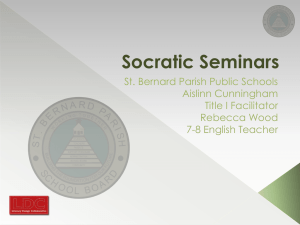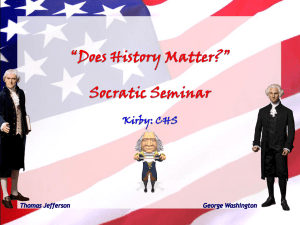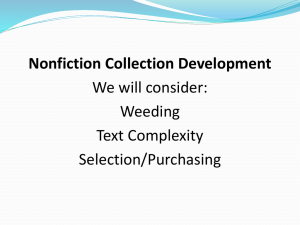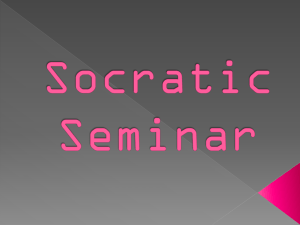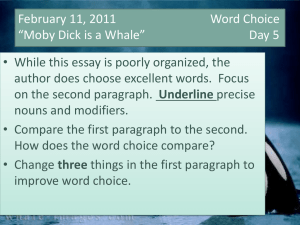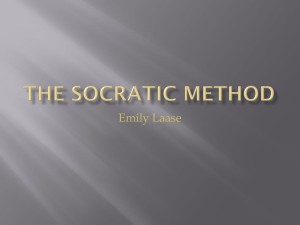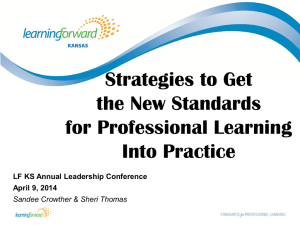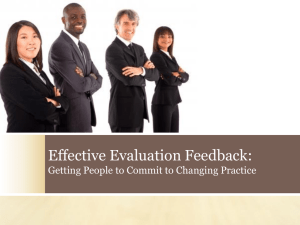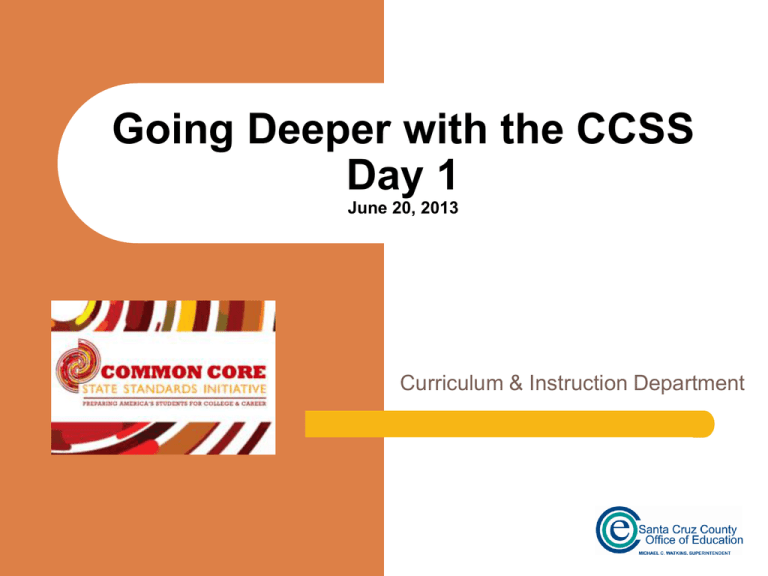
Going Deeper with the CCSS
Day 1
June 20, 2013
Curriculum & Instruction Department
Participants will…
Develop an understanding of the instructional
shifts required by the CCSS
Engage in an integrated instructional
sequence
Apply strategies & practices to a planned unit
of instruction
New Societal Requirements
New Standards
New ELD Standards
Next Gen
Science Standards
New H/SS Standards?
Common Core
(ELA/Math)
Common Core Standards Criteria
Rigorous
Clear and specific
Teachable and learnable
Measurable
Coherent
Grade by grade standards
Internationally benchmarked
A Portrait of a College and Career
Ready Student….
Students who are college and career ready in
English Language Arts …
Demonstrate independence
Build strong content knowledge
Respond to varying demands of audience, task, purpose and
discipline
Comprehend as well as critique
Value evidence
Use technology and digital media strategically and capably
Understand other perspectives and cultures
SEE HANDOUT – ARE OUR STUDENTS PREPARED?
Major Shifts in ELA
Building knowledge through content-rich
nonfiction and informational texts (R.10)
Reading and writing grounded in evidence
from the text (R.1; W.1)
Regular practice with complex text and its
academic vocabulary (R.10; L.6)
“The Standards define what all students are
expected to know and be able to do, not how
teachers should teach.” (Intro., p. 6)
Write arguments to support claims with clear
reasons and relevant evidence
Create an organizational structure
Develop the topic with relevant facts, definitions,
concrete details, quotations, or other information and
examples
Ask and answer questions to demonstrate
understanding of a text, referring explicitly to the text
as the basis for the answers
In ELA/Literacy
Teachers can begin doing these things now….
Begin to incorporate more informational text
Incorporate into instruction more text-dependent questions
that require students to read a text closely to determine what it
says explicitly and to make logical inferences from it
Have students read more non-fiction and complex texts
Encourage questioning, discussion and explanation of
thinking
Focus writing instruction substantially on writing to inform and
structure an argument, not only writing stories
Create assignments with real-world application
HANDOUT –
WHAT COMMON CORE ELA INSTRUCTION MIGHT LOOK LIKE
Standards for Mathematical Practices
Mathematically Proficient Students:
1.
Make sense of problems and persevere in solving them
2.
Reason abstractly and quantitatively
3.
Construct viable arguments and critique the reasoning of others
4.
Model with mathematics
5.
Use appropriate tools strategically
6.
Attend to precision
7.
Look for and make use of structure
8.
Look for and express regularity in repeated reasoning
HANDOUT – STANDARDS FOR MATHEMATICAL PRACTICE
Major Shifts in Mathematics
1.
Focus: Focus strongly where the standards
focus.
2.
Coherence: Think across grades, and link to
major topics
3.
Rigor: In major topics, pursue conceptual
understanding, procedural skill and fluency,
and application
What do the New Math Standards
Imply
“Mathematically proficient students
understand and use stated assumptions,
definitions, and previously established results
in constructing arguments. They make
conjectures and build a logical progression of
statements to explore the truth of their
conjectures… They justify their conclusions,
communicate them to others, and respond
to the arguments of others.” – (CCSS for
Mathematics, p. 6)
What will our student mathematicians
need to be able to do…..
Communicate (orally, in writing, and through other
representations) about concepts, procedure, strategies, claims,
arguments, and other information related to problem solving:
Create, label, describe, and use in presenting solutions to a
math problem multiple written representations of a problem
Explain in words orally or in writing relationships between
quantities and multiple representations of a problem solutions
Present information, description of solutions, explanations, and
arguments to others
Respond to questions or critiques from others
Ask questions about others’ solutions, strategies, and
procedures for solving problems
http://www.ccsso.org/Resources/Publications/The_Common_Core_and_English_Language_Le
arners.html
In Math
Teachers can begin doing these things now…
Focus instruction more on the few key topics emphasized
in each grade in the standards
Emphasize problem-solving and real-world application
Provide opportunities for students to access different
mathematical practices
Support mathematical discussions and use a variety of
participation structures
An Integrated Model Lesson Using
Text Sets
Reading
Standard
1.0
Reading
Standard
10.0
Writing
Standard
1.0
Listening and
Speaking
Standard
1.0
HANDOUT –STANDARDS R.CCR.1, R.CCR.10, W.CCR.1, SL.CCR.1
Text Complexity Defined (R.10)
1. Qualitative measures – aspects of text complexity best measured or
only measurable by an attentive human reader (levels of meaning and
purpose, structure, language conventionality, knowledge demands)
2. Quantitative measures – aspects of text complexity…that are difficult
if not impossible for a human reader to evaluate efficiently, especially in
long texts, and are thus today typically measured by computer software.
(Lexile)
3. Reader and Task considerations – variables specific to particular
readers (such as motivation, knowledge, and experiences) and to
particular tasks (such as purpose and the complexity of the task assigned
and the questions posed). Best made by educators using professional
judgment.
Qualitative Measure
Use to identify specific grade levels….
With an elbow partner,
discuss the following
questions:
•
•
IN HANDOUTS
Will spending time helping
students to establish a
purpose for reading a text
be appropriate?
Will students know in
advance what they are
expected to do with the
information they gain from
reading this text?
Quantitative Resources
Fry Readability Formula
Dale – Chall Readability Calculator:
–
http://www.readabilityformulas.com/free-dale-chall-test.php
Others:
–
–
–
–
http://www.lextutor.ca/vp/eng/
http://lexile.com/analyzer/
ATOS (Accelerated Reader Program)
Coh-Metrix (University of Memphis)
HANDOUT – FRY READABILITY GRAPH
Quantitative: Aligning Lexile Ranges to CCR
Use to identify specific grade bands…
Figure 3. Text Complexity Grade Bands and Associated Lexile Ranges (in Lexiles)
Text Complexity Grade
Band in the Standards
Old Lexile Ranges
Lexile Ranges Aligned to
CCR Expectations
K-1
N/A
N/A
2-3
450-725
450-790
4-5
645-845
770-980
6-8
860-1010
955-1155
9-10
960-1115
1080-1305
11-CCR
1070-1220
1215-1355
© Copyright 2010. National Governors Association Center for Best
Practices and Council of Chief State School Officers. All rights reserved.
The way Lexile is measured has not been changed; it has been
adjusted in order to address the gap between texts read near the
end of high school and university
19 texts.
Reader and Task
Students need opportunities to stretch their
reading abilities but also to experience the
satisfaction and pleasure of easy, fluent
reading within them, both of which the
Standards allow for.
–
Activity - Review the checklist from Fisher and
Fry. With a partner, discuss how you might use
this as a tool for selected appropriate texts for
your students.
HANDOUT – CHECKLIST FOR MATCHING READER AND TASK
Where to Begin a Lesson….
What is an ESSENTIAL QUESTION?
Essential questions reside at the top of Bloom's Taxonomy
(Bloom, 1954).
Essential questions spark our curiosity and sense of wonder.
Answers to essential questions cannot be found. They must
be invented.
Essential questions engage students in the kinds of real life
applied problem-solving suggested by nearly every new
curriculum report or outline curriculum standards
HANDOUT – USING ESSENTIAL QUESTIONS…
Strategy - Note-taking Guides
Scaffolding to support the reading of complex text…
Who
What
Where When
Why
Cornell Notes - Format
HANDOUT – THE
CORNELL NOTETAKING SYSTEM
Cornell Notes - Process
Complete
AFTER class
Complete
DURING class
AFTER class
Retention
Curve of Forgetting
~ University of Waterloo
HANDOUT – THE CURVE OF FORGETTING
Stop and Jot: What do you think?
What makes a good leader?
–
Take 3 minutes to write your answer to this
question in your Cornell notes.
Turn and Talk (purposeful collaboration)
–
Share your response with a partner. Be prepared
to share THEIR thinking.
What Makes a Good Leader?
What leadership traits do these
women have in common?
Collaborative Conversations (SL.1)
Think-Pair-Square
–
–
Discuss the topic with your partner (1 min each)
Extend the discussion with another set of
partners, but this time, share a summary of your
partner’s response (30 seconds each)
Add any new or significant ideas to your own notes!
Read Aloud
Lucy Calkins – “Reading
the CCSS As if They Are
Gold”
Interactive Triads
IN HANDOUTS
Partner Read
Mandela: His 8 Lessons of Leadership
Mandela launched a campaign to persuade the ANC that his
was the correct course. His reputation was on the line. He
went to each of his comrades in prison, Kathrada
remembers, and explained what he was doing. Slowly and
deliberately, he brought them along. "You take your support
base along with you," says Ramaphosa, who was secretarygeneral of the ANC and is now a business mogul. "Once you
arrive at the beachhead, then you allow the people to move
on. He's not a bubble-gum leader — chew it now and throw it
away."
-Time Magazine, July 9, 2008
HANDOUT – LEAD FROM THE FRONT…
Annotation is a note of
any form made while
reading text.
“Reading with a pencil.”
Modeling
in 9th
Grade
English
Strategy to Scaffold the Reading of
Complex Text: Marking the Text (R.1)
–
Before reading number the paragraphs in your section.
–
While reading, circle key words/phrases that are used to
explain an idea or concept.
–
While reading, underline author’s claims and/or other
information relevant to the reading purpose. While
reading informational texts, focus on identifying
information relevant to the reading task such as… central
claims, evidence, facts, descriptions, cause and effect
relationships.
HANDOUT – TEXT MARKING STRATEGY
Lincolns Life and Work…..
Read “Lincoln’s Life and Work” to further your
notion regarding the traits a good leader
As you read:
Number
Paragraphs
Underline claims
Circle descriptive words
After reading:
Add
any new ideas to your
Cornell Notes
HANDOUT – LINCOLN’S LIFE AND WORK
Leaders – Another Perspective
Is morality a quality of leadership?
Stop and Jot… Then, Turn and Talk….
Video – Lollipop Moments
“Never doubt that a small group of thoughtful, concerned citizens can change
world. Indeed it is the only thing that ever has.” ~ Margaret Mead
Frames to Develop Claims and
Counter Claims (6 – 12)
I think the qualities of a good leader are
……because…….
Some characteristics of good leaders are _______,
_______ and _______.
Similar to the leadership demonstrated by _______, good
leaders __________.
Starting with the counter argument…
Although some people believe.. it may be argued..
Some people feel that.. In reality, however….
Despite…… I want to argue that……
Socratic Seminar
CCSS.ELA-Literacy.CCRA.SL.1 Prepare for and participate effectively in a range of
conversations and collaborations with diverse partners, building on others’ ideas and
expressing their own clearly and persuasively.
Purpose:
To develop a deeper
understanding of complex
ideas through rigorously
thoughtful dialogue, rather
than by memorizing bits of
information.
4 Elements of Socratic Seminar
1.
The Text
–
–
–
Readings from Literature, science,
history, math… Any content area.
Works of art, artifacts, media, music
Texts should be selected for their
richness in ideas, issues, and
values and their ability to stimulate
extended dialogue.
4 Elements of Socratic Seminar
2.
The Questions
–
–
Opening: no right answer, genuine
curiosity of leader, leads participants to
the text
Core: content (text) specific, interpret a
line, passage, or event, ask how or why
o
o
–
Prepare these ahead of time
Go beyond the obvious!
Closing: connect to world/self, establish
relevance
4 Elements of Socratic Seminar
3.
The Leader
–
–
–
–
Approach seminar as a joint search for
understanding
Help clarify positions, probe responses
Facilitate the flow of discussion – both content
and participation
Model respectful dialogue & behavior
4 Elements of Socratic Seminar
4.
The Participants
–
–
–
–
Prepared – have read the
passage at least once
Share ideas & questions,
agree/disagree with each
other
Search for evidence in the
text
Listen actively!
Socratic Seminar
Gather your notes on
leadership and any texts we
have used
See the sticker on the front of
your packet to see where to
go.
Find a seat
Develop one or two questions
on leadership that might lead
to a good discussion
Socratic Seminar
Remember to:
–
–
–
–
–
Speak
Reference the text for
evidence
Ask questions
Listen
Build on the ideas of others
Morality is/isn’t a quality of leadership
because_________________, as we
saw/read/discussed in ____________.
One piece of evidence for this is
____________________. Another…..
Strategy - Flash Draft #1
W.Standard 10 – Range of Writing (long and short time frame)
Flash Draft:
–
–
–
–
Write thoughts from readings in words you might use in your
final draft.
Write in one period (approx. 60 min.)– quickly and concisely
to get words/ideas down on paper.
Put flash draft #1 aside and later repeat with #2 before
completing final draft.
Notice and name differences in papers and reasons why.
With
an elbow partner, discuss how this might be adapted
for your grade level?
Your Turn to Try it Out….
Flash Draft #1 –
We have been learning about leaders. You will have
this class period to tell us in writing what you think
about leadership. Don’t worry about editing and
format. Write your thoughts from our readings in words
your might use in your final draft. Be sure and give
your opinion and reasons/evidence for why you believe
the way you do.
Leadership Prompt – Final Draft
Writing Directions: Today you have learned
a lot about leaders. You will now have a
chance to write an opinion paper about what
you think are the qualities of a good leader.
You will state an opinion about leadership,
supply relevant facts and reasons that
support your opinion, quoting sentences or
phrases from your resources, and write a
conclusion.
Strategies Used Today
Essential Questions
Stop and Jot
Cornell notes
Collaborative
Conversations
Listening with a
purpose
Partner Reading (w/
scaffold)
Marking the Text
Sentence Frames
Socratic Seminar
Flash Draft
Primary Resource Websites
Library of Congress http://www.loc.gov/index.html
Calisphere http://www.calisphere.universityofcalifornia.edu/
National Archives (DocsTeach http://docsteach.org/
American Rhetoric http://www.americanrhetoric.com/
World History Matters http://worldhistorymatters.org/
Lesson Planning & Next Steps
Develop an Essential Question for your unit
of study
Identify resources to build a text set

